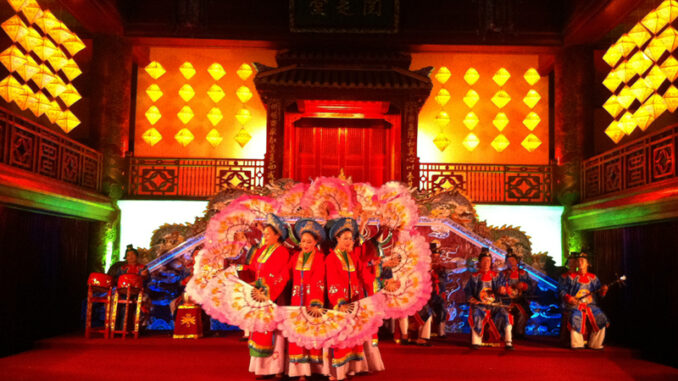
It is also known as Hue Royal Court Music, which means “elegant music of the Hue royalty” in Vietnamese. In royal events, this performing art usually appears at the opening and closing ceremonies. Its orchestra includes musicians wearing the Ao Dai and turban who play traditional instruments like the erhu, flute, 16-string zither, etc.
Back in the 19th century, this genre was considered national music because it showed the royal dynasty’s influence in every aspect of life. Besides, despite the word “royal” in its name, this genre was prevalent among both aristocrats and commoners.
History of the formation through feudal eras
According to historical records, Hue royal court music had a process of formation and development in stages through the Ly – Tran dynasties. Successive generations continue to preserve, add creativity, and develop this art form increasingly rich and sophisticated, reaching its peak during the Nguyen Dynasty.
Under the Ly dynasty
Royal court music existed from the Ly dynasty (1010 – 1225) and began to operate in a regular manner later. At this time, Nha Nhac had elegant lyrics and noble melodies, symbolizing the longevity, prosperity, and power of the feudal monarchy.
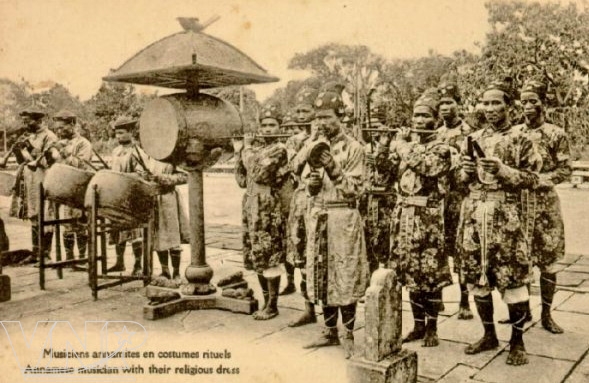
Under the Le Dynasty
From the Le Dynasty, Nha Nhac was divided into many separate genres such as Giao Nhac, Dai Trieu Nhac, Mieu Nhac, Dai Banh Nhac, Thuong Trieu Nhac, Cuu Nhac Nhac, Cuu Nhac Nhac, Nhac Nhac…
However, at the end of the Le Dynasty, Nha Nhac could no longer maintain its development and began to enter a period of decline and fading due to many different reasons.
Under the Nguyen Dynasty
Hue royal court music developed strongly again and was systematically organized during the Nguyen Dynasty (period 1802 – 1945). Especially in the first half of the 19th century, King Gia Long’s court knew how to use this scholarly music genre for “spiritual nourishment” when he first established his career in the South.
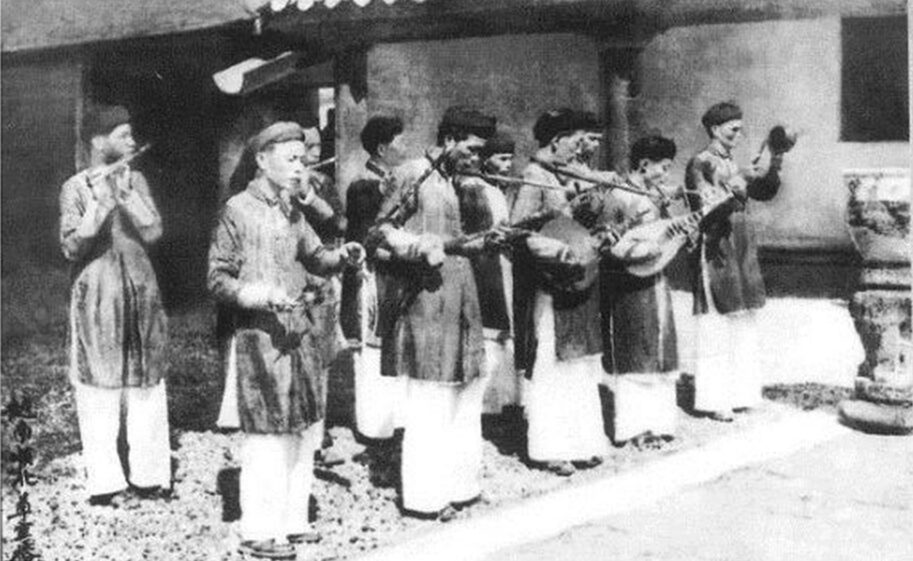
From here, Nha Nhac was closely associated with the Hue royal court and developed according to a standard, systematic, and methodical model with hundreds of musical pieces. This period was also an important preparation step, creating a premise for the development of Royal Music through the following kings.
Hue Royal Court Music nowadays
Today, Hue royal court music with forms such as orchestra, songs, and dances is performed on many occasions such as Hue Festival, Buddhist festivals, folk festivals, chamber music…
Court music is also performed in diplomatic ceremonies, performed for tourists and local people during major holidays and traditional Tet holidays… That’s why, today court music still has the conditions and space to perform rich music. Artistic value is still preserved, lasting, and continues to be promoted.
Preservation and conservation
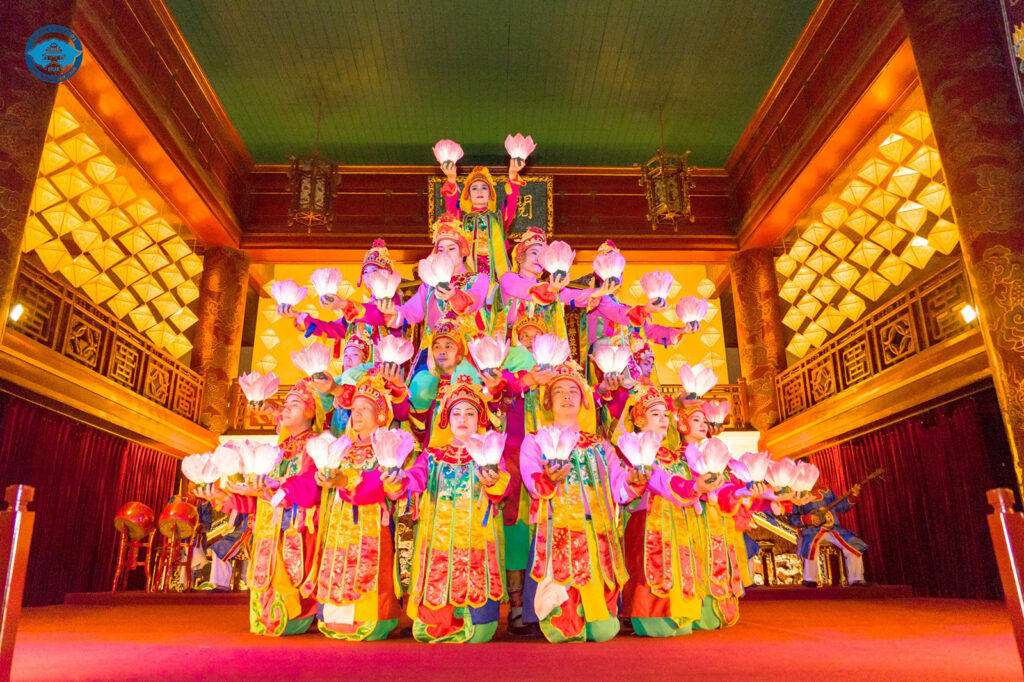
Hue royal court music can be considered an invaluable asset of our nation. This value needs to be preserved and promoted in contemporary society. Despite many difficulties, conservation has achieved many good results with specific work as follows
– Royal court music has been preserved since 1992. Over the next few years, the preservation of royal court music has gradually gone into orbit.
– Important Hue royal court music songs have been preserved by the Hue Royal Traditional Arts Theater such as 10 Ngu versions including Pham Tuyet, Ho Quang, Nguyen Tieu, Binh Ban, Lien Hoan, Hue Royal Court Music – Luu Thuy Kim Tien, Tay Mai, Phong Phong, Tau Ma, Long Tiger… and some songs in the Dai Nhac orchestra.
– Hue Royal Traditional Arts Theater also performs court music through various forms of performance on occasions such as Hue Festival, Buddhist festivals, folk festivals, some diplomatic ceremonies, and costume performances serving Hue tourists to visit, learn about…
Recommend some places to enjoy
- Duyet Thi Duong Theater
Built nearly 200 years ago under the Nguyen Dynasty, this is the first theater to organize performances of Hue Royal Refined Music. It was also a venue for other performing arts like Vietnamese opera and dance. Nowadays, apart from being a theater, it offers an exhibition, a souvenir shop, and royal cuisine. After seeing the performance, you can have a tour around the famous Imperial Citadel of Hue.
– Address: The Imperial Citadel, Phu Hau, Hue City
– Showtime: 10 AM – 10:40 AM; 3 PM – 3:40 PM
– Ticket price: $8,14
- Perfume River
When the sun goes down and the lights go up, the Perfume River is sparkling with all colors of the stylized dragon boats. These transports unhurriedly drift in the mist while the audience attentively watches the appealing music show, making a wonderful experience. Each show lasts for one hour, including sightseeing time and time for releasing lanterns into the Perfume River.
– Address: Toa Kham Boat Station, 49 Le Loi Street, Phu Hoi, Hue City
– Showtime: from 7 PM or 8 PM
– Ticket price: $4,07
When was it recognized by UNESCO?
Hue “Nha Nhac” Vietnamese Court Music was recognized by UNESCO as an intangible cultural heritage and oral tradition of humanity on November 7, 2003, and the recognition ceremony was held in Paris, France on January 31, 2004.
This is a great honor and pride for Hue as well as the Vietnamese people. At the same time, this honor also contributes to creating a unique attraction for the tourism industry of the ancient and poetic city of Hue.
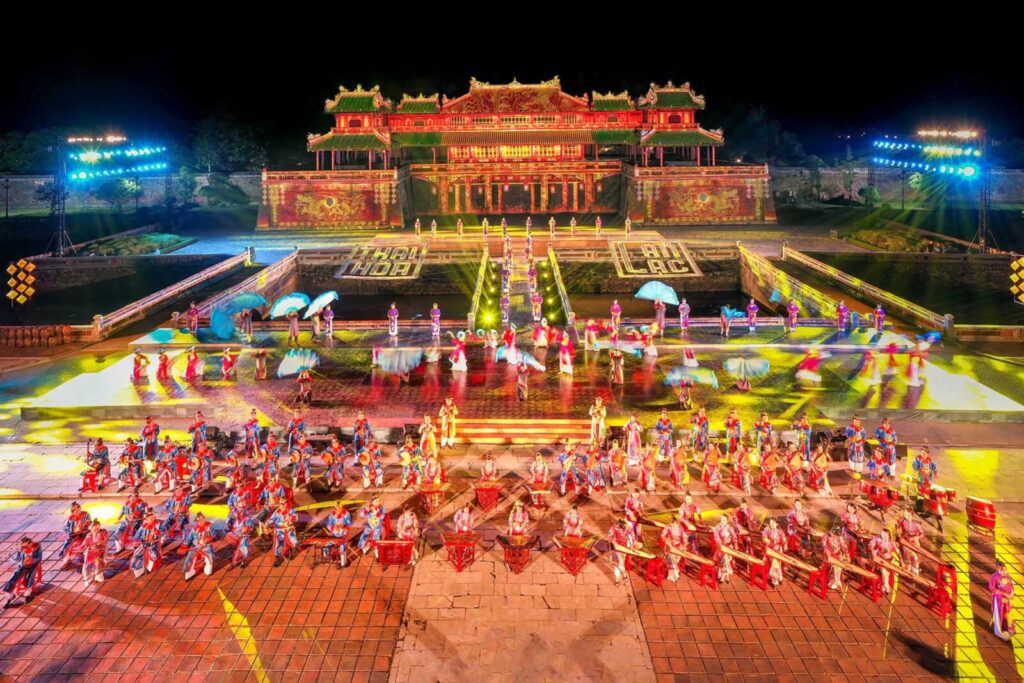
Conclusion
Distinctive and historic as it is, Hue Royal Court Music is a form of art that you will not find anywhere else. In comparison with catchy and vibrant songs on music charts, Hue Royal Refined Music might seem outdated and unattractive. But once you feel the serene ambiance of Hue City, you will feel the music’s power even without understanding a single word.
Get an opportunity to visit Intangible World Cultural Heritage in Vietnam through Vietnam E-Visa!